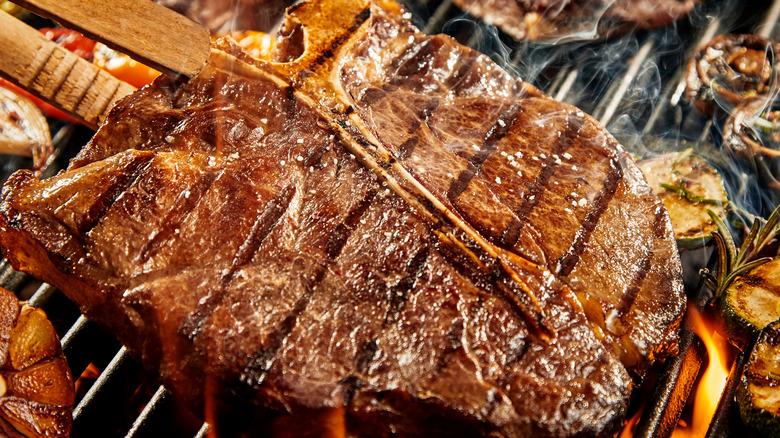Why Andrew Zimmern Prefers The Reverse Searing Method For Beef
A good cook, whether a celebrity chef or your mom, knows how to build flavor while cooking. Julia Child knew this and showed Americans how to get the most flavor out of their ingredients for the first time on television. Seasoned cooks know when a squeeze of lemon will brighten a dish, how to balance a spicy recipe, or that even salads should be seasoned with salt.
Whether it's a steak or Child's famous Boeuf Bourguignon, stewed meat is elevated with an additional flavor-enhancing step, searing. On her show, Child demonstrated drying beef with a paper towel, warning that any moisture on the meat would steam the beef instead of browning it. The chemical process liable for that browning, known as the Maillard Reaction, is responsible for creating new aromas, flavors, and colors on the surface of beef.
Under the right circumstances, the combination of heat, moisture, and time allows the meat's proteins and sugar to bond, caramelize and add depth to your dish, making the steak more appealing in every way. The aroma lets your brain know a delicious meal is coming, making you salivate. Finally, there are the umami flavors that make your mouth happy.
Although cooks agree on the importance of searing, there are two schools of thought on the method. According to a recent post, chef Andrew Zimmern prefers the reverse searing method.
What is reverse searing?
Until the early 2000s, chefs seared meat at the beginning of the cooking process, 'locking in the meat's juices,' (per Serious Eats). Although we now know that searing doesn't lock in anything, the importance of this step is still understood. Searing is all about flavor.
As meat cooks, it does so from the edge to the center, creating uneven cooking. The hotter the cooking source and the thicker the cut, the greater the difference is, and this creates a dried-out layer of meat. Cooking a thin steak versus a two-inch expensive steak requires different techniques, and so, the reverse sear was developed.
To achieve a more evenly cooked steak, chefs like Zimmern prefer reverse searing, which simply means searing the steak at the end of the cooking process. While grilling a tomahawk steak on Instagram, Zimmern explains how he first slow-cooks the steak over indirect heat before searing it over high heat to create a flavorful crust. Home cooks can start the meat in a low oven before searing it over high heat when in the kitchen. A cast iron pan is ideal for searing a steak.
Zimmern promotes reverse searing when cooking thick cuts of meat, calling the method 'more forgiving.' Since the meat is cooked, the surface is already dried out, making achieving the Maillard Reaction easier. Plus, your window of time to reach the desired doneness is greater when cooking at lower temperatures, giving you more time to nail the best medium-rare steak.

